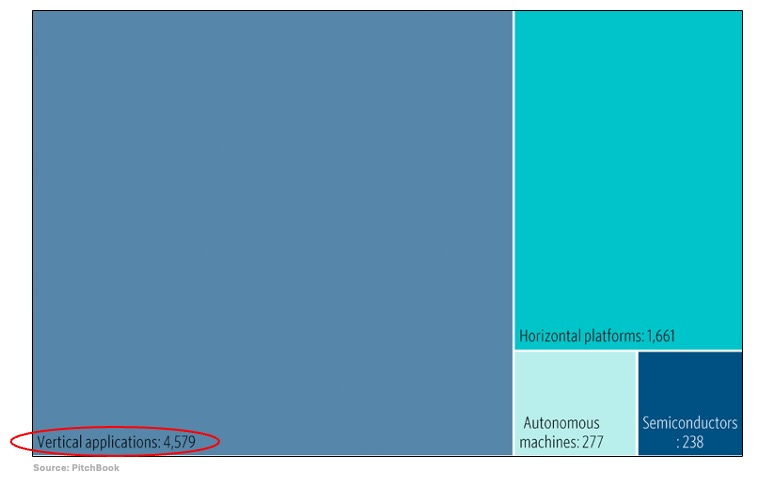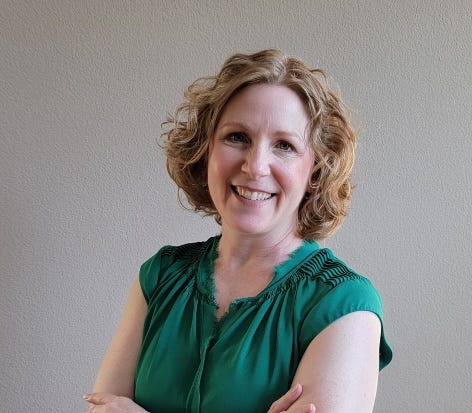There’s Money in AI. There’s Profit in Vertical AI.
Vendors, solution providers, and MSPs are proving it. Plus: Slide’s contrarian take on platforms and how GoTo and AVANT are approaching telco/IT channel convergence.
It’s so easy to miss where the real money is in AI these days.
Sure, the astonishing $40 billion OpenAI raised this week is, you know, real money, as are the $6 billion xAI raised last December and the $3.5 billion Anthropic raised last month. Businesses will shell out nearly $579 billion in 2025 just on genAI endpoints and servers, according to Gartner. And CoreWeave, while not everyone’s AI investing cup of tea, was worth more than $22.6 billion when markets closed today despite seeing its shares drop 21.9% over the last two utterly miserable trading days.
Yet if your name’s not Sam Altman, say, or Jensen Huang, are horizontal businesses like that really where the money is in AI? Not according to startup founders. 4,579 of the 6,755 early-stage AI and machine learning startups PitchBook was tracking at the close of 2024 were working in vertical AI:
Not according as well to healthcare AI vendor Abridge, which raised $250 million at an estimated valuation of $2.5 billion late last year, or legal AI vendor Harvey, which raised $300 million two months ago following a “milestone year” in which ARR grew 400%.
And not, last but hardly least, according to ePlus, the solutions and managed services giant I’ve written about here before, which says that enrollees in the AI Ignite program it rolled out last year have had way more interest in customized vertical solutions trained on in-house data than in horizontal IT and productivity use cases.
“We definitely see the vertical area as one that folks want to talk about a lot,” says Lee Waskevich, vice president of security at ePlus and co-manager of the company’s cloud and AI practices. And predictably so, he adds.
“A lot of the more generic AI applications, simple chatbot functionality, [Microsoft] Copilot, things like that, many times those can be very rinse and repeat,” Waskevich says. “These vertically specific solutions have the potential in some cases to transform how that business actually conducts itself.”
Think about a hospital using archived medical data to suggest treatment options proven to reduce readmittance rates, for example, or a local government turning permit applications and license renewals into an automated concierge experience available 24/7.
For the companies building them, solutions like that are not only far more profitable than slinging Copilot licenses but much, much stickier as well, and they get you into conference rooms with a different class of end user. “The conversation we’re having is definitely not an IT conversation,” notes Corey Kirkendoll (pictured), CEO of Dallas-based 5K Technical Services. “It’s the chief marketing officer, it’s the head of HR, it’s the CFO, it’s the CEO, it’s the chief revenue officer.”
Or, at one of the law firms Kirkendoll supports, perhaps a managing partner more than willing to spend freely on a solution that automatically collects data about client conversations from Copilot and VoIP solutions before dropping it into a line-of-business solution like Harvey or Clio.
“It knows who was on the call, how long the call was, what the transcript of the call was, what the breakdown of the call was,” Kirkendoll says. It can then bill for the call without human assistance as well.
Useful but relatively modest outcomes like that come early in the “crawl, walk, run” process Kirkendoll employs with vertical AI, which ePlus employs as well. Every business has workflows it would like to shorten, costs it would like to trim, capacities it needs to add, Waskevich notes. “We focus on those tactical areas first and their pain points,” he says. Then, having registered a quick win or two, they encourage the client to think much, much bigger.
“We have them give us the golden view of what perfect would look like,” Waskevich explains. “If you were to start from a clean slate and be able to solve this problem, manufacture a widget, treat a patient, or deal with community and constituents, what would that look like?”
Solutions capable of answering that question require more than foundation models and apps. They require services. Lots and lots of margin-rich services, beginning with data aggregation and cleansing.
“At the end of the day, any interactive AI capability is only going to be as good as the data you’re feeding it,” says Larry McLean, chief growth officer at O’Fallon, Ill.-based solution provider McLean Forrester. “If the metadata isn’t there to explain what the product is, how it’s used, etc., then it’s not going to be very successful.”
Getting security and backup in place for that data is important too, as is end user training. And most of that is one-off project work. There are recurring revenue opportunities as well. AI technology shifts approximately every five minutes, Kirkendoll notes, which means a solution based on AI technology must continually evolve as well.
“It needs to be maintained. It needs to be updated. It needs to be changed. It needs to be tweaked,” he says. “It becomes a managed AI kind of a concept.”
Investing in sweat equity
All of this takes technical know-how and consulting chops that many (OK, most) MSPs lack at present.
“There’s a long way to go for the channel to be fully ready to be the, quote-unquote, experts at this and go in there and be able to knowledgeably tell the customers what they need to know and have the right solutions,” says Carolyn April, vice president of research at GTIA.
IT providers looking to get started should be prepared to part with time and money. “There’s some investment in some AWS infrastructure, some Azure infrastructure,” Kirkendoll notes. There will probably be hiring to do as well, Waskevich continues, and not just to acquire AI skills. Having account managers with industry knowledge is useful too.
“It helps out tremendously because they understand the systems, the lingo, the compliance areas, all the players in the space, what others are doing,” Waskevich says.
And all of that comes after untold hours of learning, adds Kirkendoll, by you and pretty much everyone on your team. “It’s a lot of sweat equity,” he says.
McLean Forrester, in fact, is just now emerging from the sweat equity phase of its vertical AI journey. “Last year, we invested some R&D funding into just experimenting,” says Heather McLean (pictured), the company’s CEO. “That led us down the road of how could we make this more secure, more customizable than just generic AI.”
Which more recently led to coding a mockup solution for use in sales meetings. “We’re building a prototype that we can demonstrate to an organization so they can see how something like this would work,” McLean explains.
Effort like that has already paid off for Kirkendoll, so much so in fact that he can’t help but toy with getting out of the comparatively commoditized business of network and device support altogether.
“If I had it my way, I would literally shut down the MSP business and focus on this 100%,” he says. “It would probably be far more successful and far more profitable, hands down.”
Slide says no to platform
That’s a bold statement, but probably not bold enough to impress Austin McChord. The former Datto CEO has a history of making arguably even bolder proclamations. While still an undergraduate in 2007, for example, he told peers that the backup company he’d recently founded would someday sell for $1 billion.
Ten years later, he brought that vow to life with a reported $500 million to spare, a transaction followed some five years afterwards by an even bigger one involving Kaseya.
And now he’s back with another bold proclamation that he all but dares you to question. At a time when every leading name in managed services, very much including Kaseya, is utterly certain that multi-function platforms are the way of the future, McChord (pictured) is moving in the opposite direction.
“We think backup is the single most important product that MSPs buy, and we think that it makes sense for MSPs to buy a best-of-breed solution for backup,” he says. “We felt like there weren’t great options out there right now, so we created one.”
The “we” in that statement is Slide, the BDR-for-MSPs vendor that McChord, former Datto colleague Michael Fass, former Cork CEO Carlson Choi, and others officially launched in February. And the evidence all of them believe proves best of breed beats platform is readily visible in platform maker BDR solutions, according to McChord, who believes most such systems feature broken, outdated interfaces.
“It almost feels like you’re wandering around a dead mall,” he says.
Slide’s solution, by contrast, is entirely new construction, starting with the Z1, a hybrid cloud on-prem appliance with AMD chips and an NVMe SSD. “It’s extremely fast, thousands of megabytes per second,” McChord says.
The cloud it connects to is flash-based as well. “Which means that you can restore information incredibly fast, and the software is built to take advantage of that,” McChord says.
That software’s also been designed to accelerate a technician’s backup work. “The ease with which the user can navigate it and then spin up a virtual machine, do a file restore, all of these different activities, whether they’re operating from a cloud instance of their backup or the device instance of a backup, is astonishingly different than the experience that they have with the other vendors in the space,” Fass says.
If all of that sounds reminiscent of Datto, Slide’s take on partnering will too. The company offers the month-to-month pricing managed service providers often prefer, for example. “It helps keep us aligned with our MSPs,” McChord says.
Slide has a larger appliance named the B1 (the “B” stands for “big”) as well as solutions for protecting data elsewhere than on servers in the works. “Our job as a backup company is to provide solutions to MSPs to backup their data wherever it’s going to reside,” Fass says.
But he and McChord both insist that Slide will remain a backup company rather than a platform vendor going forward. “All of these backup vendors have gotten folded into these larger sort of conglomerations and big businesses,” McChord says. Slide’s refusal to follow suit, he believes, gives it a competitive edge.
That’s another bold proclamation to be sure, but I’m not sure I want to make the same mistake so many Rochester Institute of Technology students once made by betting against the man.
Like the rest of us, GoTo’s still waiting for channel convergence
Logically, businesses these days should want one partner for all things technology, not one for communications and connectivity and another for IT services. Just as logically, the lines separating telco partners from IT partners should be fading from view as a result. And they are, only incompletely and very slowly, as a couple of conversations made clear last week during the Channel Partners Conference & Expo/MSP Summit in Las Vegas.
Not coincidentally, that event exemplified the state of so-called “channel convergence” today in both design and execution. Hosted by the same corporate parent at the same time at the same Las Vegas hotel, the twin shows featured separate content tracks and separate expo halls containing mostly different exhibitors, one for telco agents and one for MSPs. So close, yet so far, in other words.
That’s exactly what they’re seeing at GoTo. The company, which merged with LogMeIn in 2016, began selling a converged set of communications, collaboration, contact center, and IT solutions under the GoTo brand back in 2022 in a move reflecting the then widespread belief that convergence was coming soon. And that belief wasn’t entirely wrong either. Some 80% of partners frequently bundle IT and telco connectivity solutions at present, according to Canalys.
Yet this January, just shy of three years after GoTo became GoTo’s sole brand, the company began offering the IT part of its portfolio under the LogMeIn name, a change reflecting the undeniable fact that while the lines between telco partners and MSPs have gotten blurrier, they still very much exist.
“The MSP who was very focused on the areas of the remote IT support, remote management, break-fix, that’s still the core of their business, but they absolutely are seeing the returns on the communication side,” observes Mike Day (pictured right), GoTo’s vice president of global partner sales. Traditional communications partners are branching out into IT services too, he adds. “But no one has completely strayed away from the core skill of what they do.”
And with good reason. “The technologies are absolutely different,” Day explains. “It might be the same company buying both types of technology, but the use case, the application, and the procurement are all very different.”
Actually, GoTo and LogMeIn solutions do have one, perhaps predictable, thing in common, and it’s shown up in a series of announcements involving both product lines during this young year alone. The most recent, which arrived a little under three weeks ago, concerned AI Receptionist, a “smart assistant” for the GoTo Connect communications platform that unlike a typical human receptionist is both happy to work 24/7 and multilingual.
“Right away, there are five different languages that can natively be spoken into it, and five more that are right behind it,” Day says.
According to GoTo, more members of the “GoTo Connect Digital Workforce” will begin arriving soon, with a whole lot of other AI-related features to follow in the years ahead.
“AI will never not be a focus,” Day says. “AI today is smarter than it was yesterday, and tomorrow it’s going to run faster than it is today.”
AVANT woos trusted advisors
AVANT has been putting its own spin on convergence for a while. A long-time communications, contact center, and connectivity distributor that later added cloud and security solutions too, the company has built its entire channel strategy around the “trusted advisor,” a familiar term with a new meaning and added relevance, AVANT believes, in a time of increasingly powerful and increasingly complicated solutions.
“The role of the trusted advisor has become a consultant, it’s become a confidante, it’s become a business advisor,” says Chris Werpy, the company’s CTO. “It’s not just, ‘give me a quote and give me a cheap price.’ These technologies and solutions are so complex that it takes someone to help them navigate that just vast sea of vendors.”
AVANT has some 400 vendors on its line card, in fact, and more coming in AI alone every week. “There’s no way the IT buyer or the CISO or the CIO can keep up with all the options that are available to them,” Werpy says, noting that a trusted advisor can help them “cut through that noise.”
Most TAs, as AVANT often calls them, are one-time telco partners, he adds, but not all of them. “We’re starting to see more and more MSPs enter the space and grow the residual side of their business,” Werpy says.
Updates that began arriving in Pathfinder, AVANT’s TA portal, last week are a big part of the company’s strategy for attracting more MSPs and other channel partners. Originally, Werpy notes, the system was largely a sales enablement tool for telco agents.
“It became a conduit, a connection point between AVANT and all of our trusted advisors, and VARs, and national partners, and it just continued to evolve with things that we can do to help them scale their business,” he says.
The new edition of Pathfinder that AVANT has been developing for over a year is designed to accelerate that process, beginning with the introduction of a new commissions feature. While earlier commission tools shared numbers with partners once a month, according to Werpy, the new one lets them analyze up-to-the-minute figures any time they want.
“As opposed to just dumping a raw data file, this is really giving them business intelligence,” he says.
There’s more BI functionality, based on real-time data from vendors on AVANT’s line card, coming in the second half of the year, according to Michael Messagie, the company’s vice president of information technology.
“They’re ready with their APIs today,” he says. “We just need to connect with them and then we can provide their data to the TAs even faster with less back office costs for us.”
Functionality aimed at enabling TAs to share some of that data when meeting with clients is in development too, adds Jake Schuman (pictured), the AVANT VP in charge of Pathfinder.
“All of this IP that’s coming together then becomes their platform that they can use in front of customers to go and appear bigger, sell more complex deals, cross-sell, upsell on their base, and go drive more revenue,” he says.
Features like that directly reflect input from TAs, Schuman adds. “All of this is done intentionally for the trusted advisors based on what they’re asking us and what they need in their own business.”
Enough reading
How about some listening, like to the interview with NinjaOne’s VP of product strategy on this episode of the podcast I co-host? Just as informative. Far less work.
Also worth noting
Ecoverse enthusiast N-able has added Derdack Signl4, Rewst, ScalePad Lifecycle Manager, SeedPod Cyber, Webroot by OpenText DNS Protection, and Xurrent to its Technology Alliance Program.
Rackspace is back in the channel with a brand-new partner program.
SentinelOne has a brand-new partner program of its own.
CyberQP has a new zero-trust security platform for IT helpdesks.
Todyl is partnering with SPECTRA to help its partners get cyber insurance faster and at better rates.
Object First, the Veeam backup storage vendor you’ve read about here before, has rolled out three new appliances with 20TB, 40TB, and a whopping 432TB of capacity.
Sherweb has introduced usecure, a new “human risk management” (think security awareness) solution.
Bitsight’s new Identity Intelligence solution uses threat intel to help security teams detect compromised credentials.
Arrow Electronics has a new AI accelerator program.
The newest release of Exabeam’s SOC platform, the company says, is the first to embrace the Open-API Standard.
Stellar Cyber has introduced the Open Cybersecurity Alliance to ease interoperability with its Open XDR platform.
LogicMonitor has achieved “In Process” FedRAMP status.
Wasabi, meanwhile, is FedRAMP Ready.
Hornetsecurity has acquired email security vendor Altospam.
CloudBolt has acquired StormForge to add machine learning expertise to its cloud FinOps platform.
John Sapone, previously of Snowflake and ServiceNow among other high-flyers, is the new CRO at NinjaOne.
Nic Ferraro, formerly Pia’s chief strategy officer, is now chief revenue officer instead in conjunction with a larger reorg and realignment.
Bill O’Connell is the new chief security officer at Commvault.
The revamped Freshworks partner program offers more flexible support for varying sales models and new benefits for providers of professional services.










